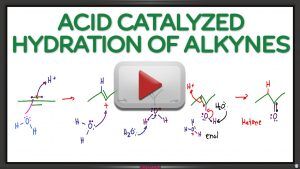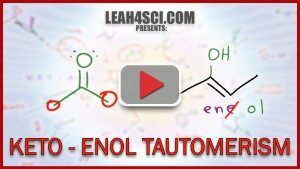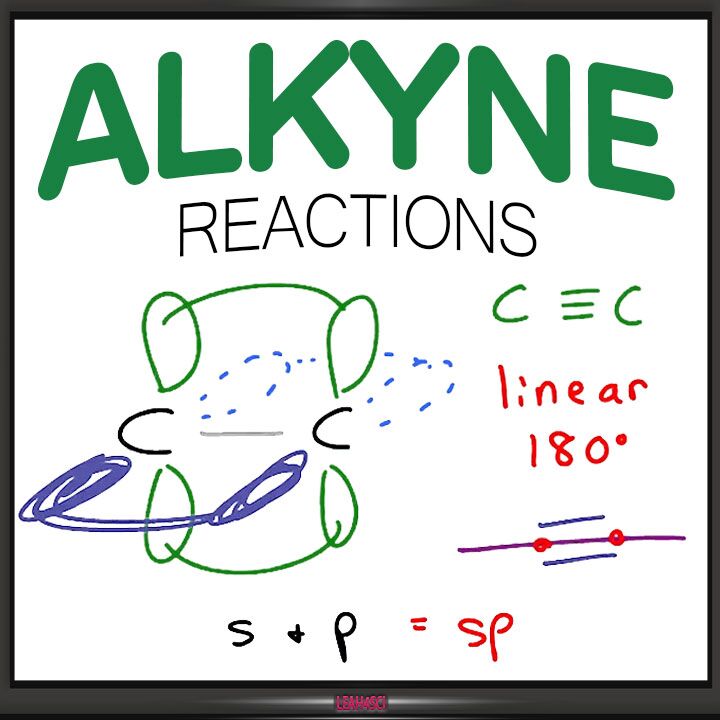 Alkyne reactions are yet another critical tool in your organic chemistry arsenal. Alkynes have a triple bond allowing for more complex reactions than their simpler alkene counterparts though the reactions are quite similar.
Alkyne reactions are yet another critical tool in your organic chemistry arsenal. Alkynes have a triple bond allowing for more complex reactions than their simpler alkene counterparts though the reactions are quite similar.
Alkynes are especially exciting in orgo 1 synthesis and retro-synthesis due to their chain elongation ability.
The video series below (in progress, to be updated in upcoming months) will take you through the basics of alkynes followed by the common reactions you’ll see in your undergraduate level organic chemistry course.
Follow along with the alkyne reactions cheat sheet. Then come back for the Alkyne reactions practice quiz (Coming Soon)
Overview – Alkyne Reaction Shortcuts
For a quick overview of what to expect for alkyne reactions (or if you’ve already studied this topic and want a super fast review) Watch the Alkyne Reaction Shortcuts. The 11 most common alkyne reactions in just 11 minutes. HOWEVER, if you’re brand new to this topic start with the tutorials below saving this shortcut video for the end.
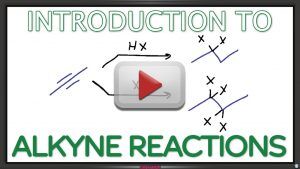 Video 1 –Introduction to Alkyne Reactions
Video 1 –Introduction to Alkyne Reactions
This video is an introduction to the concept of alkynes including an overview of alkyne hybridization and reactivity, properties and an introduction to the upcoming alkyne reactions.
Start here to get grounded with alkynes as you prepare to tackle more in depth reactions.
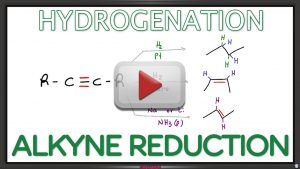 Video 2 – Alkyne Reduction
Video 2 – Alkyne Reduction
With 2 pi bonds the alkyne has various options for hydrogenation or reduction.
This video walks you through all 3 reduction reactions – to alkane or cis vs trans alkene, as well as a step by step walkthrough of the radical reduction reaction mechanism for alkyne to trans alkene.
Video 3 – Acid Catalyzed Hydration of Alkynes
Alkynes, like alkenes, can undergo acid-catalyzed hydration. This is a slow and lesser favored method, used primarily for internal alkynes. This video walks you through the alkyne hydration reaction and mechanism.
Video 4 – Oxymercuration Demercuration of Alkynes
An alkyne reacts with a mercuric ion catalyst to form a ketone product at the more substituted position, following Markovnikov’s rule. This video covers the step-by-step alkyne oxymercuration mechanism, including Keto Enol Tautomerization to isomerize an unstable enol intermediate. It also explains the regioselectivity of the reaction, when starting with an asymmetrical alkyne.
Video 5 – Hydroboration Oxidation of Alkynes
An alkyne reacts with a boron-containing reagent, followed by NaOH and H2O2, to form either an aldehyde or ketone product at the less substituted, anti-Markovnikov position. This video covers the step-by-step alkyne hydroboration oxidation mechanism, including Keto Enol Tautomerization to isomerize an unstable enol intermediate in a basic environment. It also explains the regioselectivity of the reaction for various starting alkynes.
Video 6 – Chain Elongation via Alkylation of Terminal Alkynes
A terminal alkyne can be used for chain elongation by alkylation in an SN2 reaction step. This video walks you through the reaction and mechanism for this method of chain elongation with a quick review of alkyne acidity and reactivity. You'll also learn a simple shortcut for quickly drawing the correct product of the reaction.

